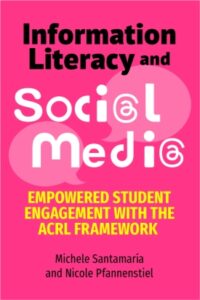Santamaria, M., & Pfannenstiel, N. (2024). Information literacy and social media : empowered student engagement with the ACRL framework. Association of College and Research Libraries.
When I started writing my book Social Software in Libraries, it was 2005 and the Internet was a very different place. YouTube was brand-new. Facebook was only open to folks with a .edu email address. Twitter came out just as I was finishing my book draft and no one I knew was using it yet. There was no FriendFeed, Vine, Instagram, TikTok, Tumblr, or Snapchat (and some of these don’t even exist today). Most people participating in social media had their own blogs and it was a really optimistic time to be in social media. It felt like a democratized space where anyone with something to say could find an audience (I say felt because, in hindsight, it was a fairly homogeneous space where certain kinds of people could find an audience). The possibilities for building collaboration and community with our patrons online seemed limitless. While there were certainly jerks and arguments online, we didn’t see abusive bots or mobbing happening the way it does now on sites like X/Twitter. I couldn’t have imagined that bad actors would one day use it to influence elections and that it would become a bot and misinformation-infested nightmare.
In 2008, I started regularly teaching a class on social media for San Jose State University and obviously I had the students actively using social media. They blogged in public throughout the course — their blogs basically were our “discussion board” and they created accounts and posted to Twitter for a week. I’m sure I had them sign up for many other things too. I didn’t worry about them being exposed to abusive content because that wasn’t prevalent back then. I let them know that their blogs would be public and that they didn’t have to use their name or any identifying information on it, but I didn’t give them another option if they didn’t want to have a public blog (something I regret in hindsight). And, from looking back to the blog post I wrote after my first semester teaching the course, it seems like the students really appreciated the format and found themselves more connected to their classmates than in something like Blackboard. But, after teaching for a few years, I kept the class blogging, but made the blogs only accessible to the students in the class. Eventually, I started teaching a class on embedding information literacy and library services into courses instead and I kept class blogging, but students didn’t need to do any posting to public social media. And as things like Gamergate happened and social media became a more abusive and negative place, I felt increasingly good about moving away from using public social media in classes.
So, when I was asked to review a new book entitled Information Literacy and Social Media: Empowered Student Engagement with the ACRL Framework, I agreed with a bit of trepidation. While I am a big believer in making my teaching relevant to students’ real lives, I’d become pretty cynical when it comes to using social media in classes. Even if they already use it, I don’t really want to encourage students to use something that has such a negative impact on young people. And it’s clear that authors Michele Santamaría and Nicole Pfannenstiel anticipated that reticence from readers, because they acknowledge the issues and make quite a strong case for its use. They recognize that social media addiction is a problem and that social media can be abusive, especially for people with marginalized identities. Pfannenstiel even discusses how her students on Twitter/X were discovered and then marketed to by paper mill bots. The authors argue that these are not reasons to avoid using social media in teaching, but discuss how these become valuable teachable moments that can make students better critical information consumers and creators. The bots provided an opportunity to discuss the motivations (commercial, political, etc.) behind bots and other bad actors online and how using specific words in posts can attract unwanted attention. Like my experience with blogging, they talk about how sterile forums in the LMS are, how little real engagement there is in those spaces, and how the use of Twitter/X in their teaching has led to longer-lasting connections. They describe how the use of social media “help[s] students interrogate how they use the internet and… help[s] students see their work, even interactions as simple as clicking a like button, as creation within internet spaces.” After reading this disturbing story in the NY Times last year, the idea of having students become more mindful of the potential impact of even minor actions (like liking a friend’s post) on social media seems like a good one.
The book is a quick read whose first third is focused on justifying the use of social media, surveying the literature, and sparking the reader’s own reflection about social media use. I appreciated their strong advocacy for focusing on students’ roles as information creators, something that often gets lost in information literacy instruction, and how they distinguished that from the more capitalistic term “producers” that was originally used by notable advocates of metaliteracy. The rest of the book is full of practical takeaways for those looking for actual ways to incorporate social media into their classroom teaching. I really liked the section of the book where the authors went through each frame of the Framework, listed the knowledge practices and dispositions relevant to social media use, and described concrete social media examples that relate to that practice or disposition. I envisioned many ways that I could use those examples in classes. They then go on to provide concrete and detailed activities that utilize social media to teach things like the importance of keywords and how to use them to discover specific conversations, how authority is constructed by influencers in the context of social media and how that relates to how authority is constructed in any space, or creating a conversation on social media around a specific reading using a hashtag. I would have liked to see more of those. What I appreciated was that some of the activities didn’t require students to actively post to social media or to create accounts on something they don’t use (those were my main objections to using social media in information literacy instruction). In some, students played the role of an observer to discover existing conversations or influencers in social media and then they created their own conversations about what they learned in their classroom groups rather than on a social media site. I could definitely get behind using social media in that way in the classroom.
I agree with Santamaría and Pfannenstiel that when we keep our teaching to the “walled garden of peer-reviewed scholarship” we do our students a grave disservice, but I don’t think social media is the only other place. In my classes, we explore searching on the free web and look at popular media too. I tend to treat all information the same way — it all deserves scrutiny/evaluation. Look into the author. Look into the publication/website/organization. What about them would make you trust them? What give you pause? What might it be “good” for in the context of your information need (since even a social media post can be a good source in specific use cases)? So I guess, to some extent, then, I do use social media in my teaching.
For those of you who work with traditional-aged college students, I imagine it would be a lot easier to get your students using a specific social media tool in the classroom. I could imagine when you’re working with 18-22 year olds, they probably all have Instagram and TikTok accounts. When my class populations frequently range from 18 (or less!)-60+ and students vary widely in terms of comfort level with technology, it’s a harder sell. If you have interest in using social media to engage your students around information literacy learning in the spaces they frequent online and to help them be more mindful about their social media use, this slim volume will give you inspiration and concrete ideas for doing so.






